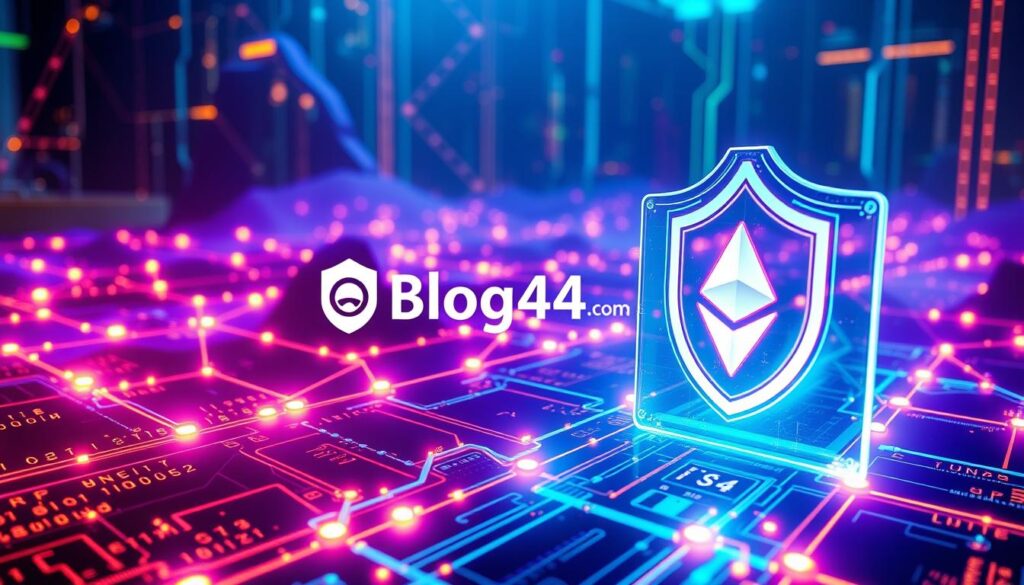In today’s digital world, cyberattacks are getting smarter. We need strong security more than ever. Blockchain technology offers a way to protect your data and change online transactions. It’s a digital ledger that’s changing how we see security12.
Ever thought about how blockchain keeps your info safe from hackers? Its unique features like decentralization and immutability fight data breaches and fraud. But how does it work, and what does it mean for your safety online?
Key Takeaways
- Blockchain technology offers enhanced security features, including data immutability, cryptographic security measures, and decentralized network structures.
- Governments and military agencies are increasingly using blockchain to improve cybersecurity and protect sensitive information.
- Blockchain’s ability to eliminate the need for passwords and provide a distributed ledger system can significantly reduce the risk of cyberattacks.
- Encrypted blockchain transactions provide a high level of privacy and confidentiality, protecting user identities and ensuring the security of financial transactions.
- The decentralized nature of blockchain makes it extremely difficult for hackers to manipulate, as altering data would require controlling the majority of nodes in the system.
What Are Encrypted Blockchain Transactions?
Blockchain technology has changed how we handle digital transactions and data. At its core are encrypted blockchain transactions. These use advanced cryptography to keep digital assets safe and private3. Bitcoin’s launch in 2009 was the first use of blockchain for a decentralized currency3.
Definition of Encrypted Blockchain
Encrypted blockchain transactions use encryption to protect data on a blockchain3. Ethereum, launched in 2015 by Vitalik Buterin, added smart contracts. This made blockchain more secure and versatile3.
Importance of Encryption in Blockchain
Encryption is key in blockchain for keeping data safe and sound3. Digital signatures and hash codes are vital for data security and stopping tampering3. The decentralized nature of blockchain boosts security, transparency, and fights fraud or manipulation3.
Blockchain has many uses, from finance and cryptocurrencies to supply chain management4. Encryption in blockchain transactions is essential for protecting sensitive info. It keeps users and stakeholders trusting the system.
“Encrypted blockchain transactions are the cornerstone of a secure and trustworthy digital ecosystem.”
How Encryption Works in Blockchain
Blockchain is built on encryption, making transactions secure and trustworthy. It uses two main encryption types: symmetric and asymmetric. Blockchain cryptography uses algorithms like SHA-256 to make transaction records unchangeable, keeping data safe and private.5
Symmetric vs. Asymmetric Encryption
Symmetric encryption uses one key for both encrypting and decrypting data. It’s quick and good for big data. Symmetric encryption is fast and great for big data, but asymmetric encryption is more secure but slower.5 Asymmetric encryption, or public-key encryption, has two keys. A public key encrypts, and a private key decrypts. Digital signatures in blockchain use asymmetric cryptography with private and public keys for security.5 Elliptic Curve Cryptography (ECC) is used in digital signatures for secure blockchain transactions.5
Hash Functions Explained
Hash functions like SHA-256 are key in blockchain. They turn inputs into unique codes. Hash functions like SHA-256 are key in blockchain, turning inputs into unique codes.5 These codes help create blocks in the blockchain, making data safe and unchangeable. Blockchain cryptography algorithms secure data within blockchain networks, ensuring private and tamperproof transactions.5 Symmetric and asymmetric algorithms handle encryption and decryption tasks in blockchain transactions for data security.5

The mix of symmetric, asymmetric, and hash-based encryption makes blockchain secure. It protects against unauthorized access and data changes.
The Role of Cryptography in Blockchain Security
Cryptography is key to blockchain security. It uses different methods to protect encrypted transactions and keep the ledger safe6. This makes blockchain a secure, tamper-proof network. It keeps data safe from unauthorized access and changes.
Types of Cryptographic Techniques
Blockchain uses many cryptographic methods to secure transactions and check user authenticity. These include public-key cryptography, digital signatures, and hash functions7. Public-key cryptography is vital for blockchain security. It lets users safely identify and talk to each other.
Benefits of Using Cryptography
Cryptography in blockchain has many benefits. It makes data integrity strong, making it hard to alter or tamper with transactions8. Hashing and digital signatures also ensure users can’t deny their part in a transaction. This boosts accountability and traceability in the network.
Cryptography also keeps sensitive information private6. By encrypting data and using secure protocols, blockchain protects user identities and transaction privacy. This is vital for finance and healthcare sectors.
The use of cryptography in blockchain is vital for its security, integrity, and privacy7. As blockchain grows in different fields, cryptography’s role will become even more important. It will keep the distributed ledger safe and maintain user trust.
Why Security Matters in Blockchain Transactions
Blockchain technology is changing how we handle digital data. Its use of consensus algorithms and digital signatures9 makes it secure. But, we must understand the risks to keep our data safe.
Common Security Threats
One big risk is a 51% attack, where hackers control most of the network9. Another issue is double-spending, where someone tries to use the same money twice9. Smart contracts can also be hacked, leading to data breaches10.
The Impact of Security Breaches
Security breaches can cause big problems, like losing money or personal data9. For governments and the military, keeping data safe is critical10. Blockchain’s security features910 help protect important information.

“Blockchain technology’s decentralized architecture and advanced cryptographic techniques are transforming the landscape of secure digital transactions, making it a game-changer in the world of data protection and financial security.”
| Security Feature | Benefit |
|---|---|
| Cryptographic Security | Encrypts transactions for enhanced privacy and confidentiality |
| Decentralized Network | Eliminates single points of failure, increasing resilience against attacks |
| Immutable Ledger | Ensures transparency and accountability by preventing data tampering |
| Consensus Algorithms | Validate transactions securely without the need for intermediaries |
Blockchain’s security features, like cryptographic security, decentralized networks, immutable ledgers, and consensus algorithms910, are key to keeping data safe. As blockchain grows, we must stay alert and act fast to protect it.
How Encrypted Transactions Enhance Privacy
Blockchain technology uses a decentralized system to protect personal data. It ensures transparency and accountability11. Encrypted transactions in this network are key to keeping user information private. They hide user identities and allow for secret transactions.
Protecting User Identities
Blockchain uses public key cryptography to keep users anonymous. Instead of sharing real names, users are known by their public keys. These keys act as pseudonyms, keeping identities hidden12.
Confidential Transactions Explained
Blockchain’s confidential transactions use advanced cryptography. They hide the amount of transactions but verify their truth11. This keeps financial info private while keeping the system open and secure.
Blockchain and data science are changing many fields. They improve healthcare, finance, and supply chain management by keeping data safe11. But, blockchain faces challenges like scaling and fitting into current data systems. It also needs standards for working with different blockchains12.
“Implementing blockchain in data science has led to advancements in security measures such as enhanced identity management and privacy-preserving technologies.”11
Blockchain combines encrypted transactions, decentralized storage, and smart contracts. It’s changing how we protect digital identities and keep sensitive info safe.
The Significance of Public and Private Keys
In the world of encrypted blockchain transactions, public and private keys are key. They ensure your digital assets are safe and private. These keys are the base for keeping your transactions secure from fraud13.
Understanding Public and Private Key Pairs
A public key is a long string of numbers that you can share. It’s used to encrypt data or verify digital signatures. A private key, on the other hand, is a secret string that unlocks your blockchain wallet13.
Together, these keys form a system that protects your transactions13. Public keys let you receive funds and check if transactions are real. Private keys encrypt your transaction details and prove you own your wallet13.
Key Management Best Practices
To keep your transactions safe, follow key management best practices. Public keys can be shared, but private keys must stay secret. This prevents unauthorized access and keeps your funds safe1314.
Creating multiple key pairs for different uses is a good idea. It lowers the risk of losing a single private key14. But, losing a private key can be very bad. There’s no way to get it back because blockchain is decentralized14.
Good key management means storing them safely, changing them often, and using special hardware. This keeps your transactions secure and protects your digital assets14.
“The security of the entire blockchain ecosystem depends on the robustness of public/private key pairs in preventing unauthorized access and fraud.”14

Knowing how important public and private keys are helps you protect your blockchain transactions. This way, you can enjoy the benefits of this new technology131415.
The Benefits of Decentralization
Decentralization is a key feature of blockchain technology. It enhances security by eliminating single points of failure. In a distributed ledger like blockchain, data is spread across multiple nodes. This makes it highly resilient to attacks16.
If one node is compromised, the network keeps operating securely. This is because the system doesn’t rely on a centralized authority. It’s also very hard for hackers to control the majority of nodes. This would be needed to manipulate the blockchain17.
Eliminating Single Points of Failure
Traditional centralized systems have a single point of failure. A breach or compromise of the central authority can cripple the entire network. Blockchain, on the other hand, is designed to be decentralized. There is no single entity controlling the network17.
This distributed architecture ensures that even if one or more nodes are attacked, the rest of the network remains unaffected. It continues to function normally16.
How Decentralization Supports Security
The decentralized nature of blockchain networks enhances security in several ways. By eliminating the need for a central authority, blockchain reduces the risk of a single point of failure. This makes it much harder for attackers to gain control of the entire system16.
Consensus algorithms, such as Proof-of-Work (PoW) or Proof-of-Stake (PoS), ensure that any attempted changes to the ledger must be validated by the majority of the network participants. This further strengthens the system’s resilience18.
The combination of decentralized architecture and robust consensus mechanisms makes blockchain-based systems highly secure. They are not vulnerable to the same types of attacks that can cripple centralized networks17. This has made blockchain technology an increasingly attractive solution for a wide range of applications. From cryptocurrencies to supply chain management and beyond16.
Real-World Applications of Encrypted Blockchain Transactions
Encrypted blockchain transactions are changing many fields. They make business safer and data handling more secure. This technology is used in finance and supply chain management, making things more transparent and secure.
Financial Services and Cryptocurrencies
Cryptocurrencies like Bitcoin use blockchain for safe and clear transactions19. In 2022, scams cost Americans up to $8.8 billion, showing the need for better security. Blockchain fights fraud with digital signatures and peer-to-peer networks20.
Blockchain also makes fast, cheap international payments. It cuts down fraud risks in banking, making transactions safer.
It also helps in verifying identities securely. This makes it easier to onboard customers without worrying about fraud.
Supply Chain Management Solutions
Blockchain is also changing supply chains19. A study by Accenture and DHL found it could save billions in logistics21. Everledger and Walmart are using it to track diamonds and food, making it faster and safer.
These examples show blockchain’s power in making things more secure and efficient. As it grows, we’ll see more ways it can help us.

Regulatory Framework Surrounding Blockchain
The blockchain world is growing fast, and so is the law around it. It’s key for companies to follow rules like GDPR and CCPA when using blockchain22. These laws help keep personal data safe on blockchain networks22.
Companies must make sure their blockchain apps follow these rules. This way, they can keep the good parts of blockchain while staying legal22.
Compliance with Data Protection Laws
Blockchain’s global reach makes it hard for regulators to keep up22. It’s tough to enforce rules against money laundering and protect consumers in a system that keeps identities hidden22. Regulators need to balance helping new ideas with keeping people safe.
Understanding GDPR and CCPA Impacts
GDPR and CCPA have big effects on blockchain23. Governments see blockchain as a way to make rules clearer and more secure24. But, blockchain’s global nature makes it hard to keep everyone in line22.
Regulators must work with the blockchain world to create rules that fit this new tech22.
The laws around blockchain are always changing. Companies need to keep up to avoid legal trouble22. By working with regulators and following the rules, blockchain businesses can thrive22.
How to Ensure Secure Transactions
Keeping your blockchain transactions safe is key in today’s digital world. Cryptography is at the heart of blockchain, protecting your transactions and digital assets25. It uses advanced techniques to offer high security and privacy, making it great for secure dealings26.
Tips for Securing Your Blockchain Transactions
- Use strong, unique passwords for your blockchain accounts and wallets.
- Enable two-factor authentication (2FA) to add an extra layer of security to your accounts.
- Keep your blockchain software and digital wallets up-to-date to ensure you’re benefiting from the latest security patches and features.
- Be cautious of phishing attempts and only use reputable blockchain platforms and exchanges.
- Monitor your blockchain transactions and accounts regularly to detect any suspicious activity.
Choosing the Right Wallet for Security
Picking the right digital wallet is vital for your transaction security. Hardware wallets, like Trezor or Ledger, are the safest as they keep your private keys offline, lowering hacking risks25. Software wallets, though easier to use, might be more at risk, so choose a trusted provider25.

By following these tips and picking the right wallet, you can greatly improve your blockchain transaction security25. Always stay alert and active to keep your blockchain transactions safe from threats26.
The Future of Encrypted Blockchain Transactions
Blockchain technology is getting better, and encrypted transactions are set to improve. New trends show a move towards better security, more privacy, and use in many fields27.
Emerging Trends in Blockchain Technology
One big trend is quantum-resistant cryptography. It aims to protect blockchain from quantum computers28. Also, zero-knowledge proofs are coming. They let us check things without sharing private info28.
Blockchain will get better with new consensus algorithms. These will use less energy and grow faster than old methods27. AI and ML will also boost security. They’ll help spot and stop threats better28.
Predictions for Security Enhancements
The future of encrypted blockchain looks bright. Decentralized networks will keep data safe from hackers27. Digital signatures and hash functions will make transactions more reliable27.
Blockchain will be used more in government, healthcare, and defense. These areas need secure data management27. With blockchain, we’ll see better security, privacy, and efficiency. This will make our digital world safer and more open28.
“The future of blockchain presents a range of possibilities for growth and innovation in industries and economies globally.”27
Addressing Misconceptions About Blockchain Security
Blockchain technology is known for its security, but myths exist. No system is completely safe from attacks. The security level in blockchain networks depends on how it’s set up and the consensus mechanism used29.
Common Myths Debunked
Many think blockchain is completely unhackable. But, it’s not entirely safe. The security depends on the consensus algorithm, network design, and security practices30.
Another myth is that all blockchains are equally secure. The truth is, security levels vary. Public networks like Bitcoin and Ethereum have strong security due to decentralization and advanced cryptography30.
Facts About Blockchain Security
Blockchain security is an ongoing effort. It needs constant attention and updates. Even with strong security features, vulnerabilities can appear. Regular checks and maintenance are key to keeping the network safe30.
The security of a blockchain network also depends on user actions and the community’s efforts. Everyone’s actions contribute to the ecosystem’s safety30.
By understanding blockchain security, you can make better choices. This ensures your transactions and data are safe and reliable2930.

“Blockchain technology is not a silver bullet for security, but it offers a robust set of tools and features that can significantly enhance the security and privacy of digital transactions and data management.”
The Role of Smart Contracts in Security
Blockchain transactions have changed how we see security and automation. Smart contracts are at the center of this change. They are digital agreements that use encryption for safe and clear transactions31. These contracts have changed many fields, like finance and real estate, by cutting out middlemen and saving time and money31.
How Smart Contracts Utilize Encryption
Smart contracts use blockchain’s encryption to keep transactions safe and prevent tampering31. Ethereum, a well-known blockchain, lets people worldwide use smart contracts31. These contracts make transactions faster and reduce errors, helping with things like lending and trading31.
In supply chain management, they make things clearer and handle payments automatically31. Even in healthcare, they help share medical records and handle insurance claims safely31.
Potential Risks and Benefits
Smart contracts have many good points but also some risks32. They can have bugs that hackers might use, and they face issues with growing, legal questions, and being complex31. Yet, experts think they will be used more, get safer, and fit better into laws31. They’re changing many areas, making things more efficient and innovative31.
In short, smart contracts are key to making blockchain transactions safer. They use encryption and automation to change many fields, from finance to healthcare. But, they also bring challenges that need to be solved. As blockchain grows, smart contracts will be important for secure and decentralized deals3233.
The Importance of Community Vigilance
Keeping blockchain networks safe is a team effort. As users, you play a big part in protecting these networks. By following best practices and staying alert to threats, you help keep blockchain technologies secure.
The Role of Users in Blockchain Security
Many blockchain projects need your help to find and report bugs. By joining bug bounty programs, you help fix security issues. Your efforts are key to keeping blockchain transactions and apps safe.
Reporting Security Issues
If you see something odd while using blockchain services, report it right away34. Smaller blockchain groups are at risk of 51% attacks. Your reports help the community and developers act fast to protect the network.
Your role as a watchful user is very important for blockchain security. By taking this responsibility seriously, you help make these networks better. They have the power to change many industries.

Final Thoughts on Staying Safe with Encrypted Blockchain Transactions
Encrypted blockchain transactions add a strong layer of security and privacy. They protect your digital assets and communications. The blockchain is built on advanced cryptography35.
Recap of Key Points
Remember, keeping your private keys safe is key. Use secure wallets and watch out for scams and hacking. Storing your assets in multiple wallets, including hardware ones, reduces loss risk35.
Also, keep up with the latest security tips and blockchain trends. This ensures the technology’s growth and adoption36.
Encouragement to Embrace Secure Practices
As blockchain tech grows, it’s vital to adopt secure practices. Understanding encryption, decentralization, and the blockchain community’s role in security is important. This helps make the ecosystem stronger37.
Using trusted wallet providers and backing up your data regularly is essential. It not only protects you but also boosts blockchain’s use in different fields35.
FAQ
What is blockchain technology?
Blockchain technology makes digital transactions safer. It uses a decentralized system to store and track information. This method is not just for cryptocurrencies but also for online shopping and health records.
Because it’s decentralized, hackers find it hard to alter data. They need to control most nodes in the system to do so.
What are encrypted blockchain transactions?
Encrypted blockchain transactions use advanced cryptography to secure data. This ensures data stays confidential and intact. Blockchains are digital ledgers that record transactions between nodes.
Nodes verify the data before adding it to the blockchain. This creates a permanent, unchangeable record.
How does encryption work in blockchain?
Blockchain uses both symmetric and asymmetric encryption. Hash functions are key to its security, creating unique data representations. These functions ensure data integrity and are used in block creation.
Each new block is encrypted, adding security to the blockchain.
What is the role of cryptography in blockchain security?
Cryptography is vital for blockchain security. It uses public-key cryptography and digital signatures to secure transactions. This ensures data integrity, non-repudiation, and confidentiality.
Why is security important in blockchain transactions?
Security is critical in blockchain transactions because of the sensitive data involved. Threats like 51% attacks and double-spending can cause financial losses and data breaches.
Secure digital communications are essential for national security, given the interconnectivity of government and military operations.
How do encrypted blockchain transactions enhance privacy?
Encrypted transactions protect user identities and enable confidential transactions. Users can remain anonymous through public key cryptography. Confidential transactions use advanced cryptography to hide transaction amounts while verifying their validity.
What is the significance of public and private keys in blockchain security?
Public and private key pairs are essential for blockchain security. The public key is shared openly for encryption and verification, while the private key is secret for decryption and signature creation. Secure storage and regular rotation of private keys are best practices.
How does decentralization enhance blockchain security?
Decentralization makes blockchain secure by eliminating single points of failure. Data is distributed across nodes, making it resilient to attacks. If one node is compromised, the network remains secure.
This distributed nature makes it hard for hackers to control the majority of nodes, necessary for manipulating the blockchain.
What are some real-world applications of encrypted blockchain transactions?
Encrypted blockchain transactions have many uses. In finance, cryptocurrencies like Bitcoin use blockchain for secure transactions. Supply chain management benefits from blockchain’s ability to create detailed, tamper-proof records.
The U.S. Department of Defense is exploring blockchain to improve national security and secure data transfer.
How does the regulatory framework impact encrypted blockchain transactions?
The regulatory framework for blockchain is evolving. Compliance with data protection laws like GDPR and CCPA is essential. These regulations affect how personal data is stored and processed on blockchain networks.
Organizations must ensure their blockchain solutions meet these regulations while maintaining security benefits.
How can you ensure secure blockchain transactions?
To ensure secure blockchain transactions, follow best practices. Use strong passwords, enable two-factor authentication, and keep software updated. Choosing the right wallet is key; hardware wallets offer the highest security.
Be cautious of phishing attempts and only use reputable platforms and exchanges.
What is the future outlook for encrypted blockchain transactions?
The future of encrypted blockchain transactions looks bright. Emerging trends include quantum-resistant cryptography and zero-knowledge proofs. Security enhancements will come from more sophisticated consensus algorithms and AI for threat detection.
As blockchain technology advances, it will be adopted in more sectors, including government and defense.
What are some common misconceptions about blockchain security?
Many believe blockchain is completely unhackable and all blockchains are equally secure. In reality, blockchain is highly secure but not invincible. The security level depends on the implementation and consensus mechanism.
Blockchain security is an ongoing process that requires vigilance and updates.
How do smart contracts impact blockchain security?
Smart contracts are key to blockchain security by automating agreements without intermediaries. They use encryption to ensure secure and transparent execution. While they reduce fraud and increase efficiency, they also pose risks, such as vulnerabilities in contract code.
Why is community vigilance important for blockchain security?
Community vigilance is essential for blockchain security. Users must follow best practices, stay informed, and report security issues. Many blockchain projects rely on community feedback through bug bounty programs.
This collaborative approach helps improve blockchain network security continuously.
Source Links
- How Blockchain Protects Government and Military Networks
- Re-examining Cybersecurity through Blockchain
- What Is Blockchain Technology? Why Does It Matter
- Blockchain: How It Works and Why It Matters
- Blockchain Cryptography: Algorithms & Basics
- The Role of Blockchain in Cybersecurity
- Blockchain Security: Key Concepts, Threats, and Future Trends
- Blockchain technology – (Cybersecurity and Cryptography) – Vocab, Definition, Explanations | Fiveable
- Blockchain for Secure Digital Payments
- Blockchain in Cybersecurity: Applications and Challenges
- Securing the Data Future: Blockchain’s Promise for Privacy & Ownership in Data Science
- Enhancing Cybersecurity Operations with Blockchain Technology: Benefits and Challenges Explained
- Private Vs Public Keys Wallets: Discover Their Key Differences
- Public/private keys – (Blockchain Technology and Applications) – Vocab, Definition, Explanations | Fiveable
- What Are Private and Public Keys? Reviewing Elements of Crytography | Simplilearn
- Blockchain and Crypto: What IT Experts Need to Know
- Unleashing the Power of Decentralization: Blockchain in Networking
- Decentralization In Crypto: Opportunities And Challenges In 2024 And Beyond | Mudrex Learn
- 17 Blockchain Applications and Real-World Use Cases 2024 | Built In
- Blockchain Use Cases In Everyday Life: Real Examples Of Practical Applications – Revinfotech Inc
- Real-Life Examples of Blockchain
- DeFi and Regulation
- Blockchain for Government Regulatory Systems
- Blockchain Identity Management: Complete Guide 2024
- Blockchain and Cybersecurity: Can Decentralization Solve the Biggest Security Challenges?
- The Future of Blockchain – Atlantic International University
- The future of Blockchain: What trends are shaping the next decade?
- Public vs. Private Blockchains: Which Is Better?
- Understanding Blockchain: The Future Of Digital Transactions
- How Smart Contracts Revolutionizing Blockchain Technology
- Smart Contracts – (Sustainable Business Practices) – Vocab, Definition, Explanations | Fiveable
- What Is the Role of Smart Contracts in Cryptocurrency Token Development?
- What is a 51% Attack, and How to Avoid It
- Crypto Safety First: How To Fortify Your Wallet And Protect Investments
- Is cryptocurrency safe?
- Why Holding Cryptocurrency Can Be Safer Than People Think

















